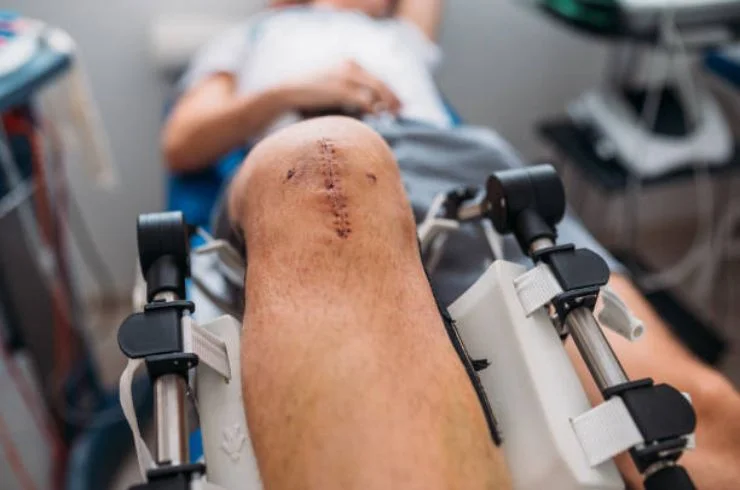Post Knee Replacement
- Home
- Treatments
- Post Knee Replacement

What is Post Knee Replacement Rehabilitation?
Post knee replacement therapy is an essential part of the recovery process after undergoing knee surgery. Whether you’ve had a total knee replacement or a partial knee replacement, physical therapy is critical to ensure that you regain strength, flexibility, and function in your knee joint. The goal is to help you return to daily activities with minimal pain, improved movement, and a stronger, more stable knee.
Why is Post Knee Replacement Rehabilitation Important?
After knee replacement surgery, the joint must heal, and the surrounding muscles, ligaments, and tissues need to regain strength and flexibility. Without proper rehabilitation, recovery can be slower, and the risk of complications, such as stiffness, muscle weakness, or loss of mobility, may increase. Post-operative physiotherapy helps in:
- Reducing Pain and Swelling: Helps to manage discomfort and prevent fluid buildup around the knee joint.
- Restoring Range of Motion: Improves the flexibility and movement of the knee joint, ensuring you can bend, straighten, and walk comfortably.
- Strengthening Muscles: Focuses on strengthening the muscles around the knee, which can support the joint and reduce the risk of future injuries.
- Promoting Faster Recovery: Proper rehabilitation can help speed up recovery, getting you back to your normal activities sooner.
What to Expect After Knee Replacement Surgery?
In the first few weeks following surgery, the main focus is on reducing pain and swelling, followed by gradually increasing movement and strength. Here’s a breakdown of what you may experience during the recovery process:
- Weeks 1–3: You will likely have some pain and swelling around the knee. Ice therapy, elevation, and medication prescribed by your doctor will help manage discomfort. Early rehabilitation will focus on gentle movement and preventing stiffness.
- Weeks 4–6: You’ll start to focus more on regaining knee flexibility and strengthening the muscles around the joint. At this stage, walking without assistance (such as a walker or crutches) becomes more achievable.
- Weeks 6–12: Strengthening exercises increase, and you may start light physical activities such as walking longer distances or engaging in low-impact exercises, depending on your recovery progress.
- 3–6 Months: By this stage, most people have regained a significant range of motion and strength in the knee, and daily activities such as climbing stairs and walking for longer periods become easier.
- 6 Months and Beyond: Continued strengthening and stretching exercises, along with maintaining an active lifestyle, will help keep the knee joint functioning optimally.
Common Challenges After Knee Replacement
Recovery after knee replacement surgery can be challenging, but with the right approach, most people regain full function. Some common challenges patients may face during recovery include:
- Pain and Swelling: Normal during the initial recovery phase, but proper therapy can manage these symptoms.
- Stiffness: A common problem during the first few weeks. Regular stretching exercises can improve flexibility.
- Weak Muscles: After surgery, the muscles around the knee may become weak. Strengthening exercises are essential to build back muscle strength and improve stability.
- Fear of Re-Injury: It’s common to be cautious after surgery. Gradual progression of exercises and a tailored rehabilitation plan can help build confidence and ensure safety during recovery.
How We Treat Post Knee Replacement at Dr. Jyotsna’s Physiotherapy Clinic
At Dr. Jyotsna’s Physiotherapy Clinic, we specialize in post knee replacement rehabilitation, providing a personalized recovery plan tailored to your needs. Our treatment approach includes:
- Individualized Assessment: A detailed assessment of your recovery progress, range of motion, and strength to determine the best rehabilitation approach.
- Strengthening Exercises: Targeted exercises to rebuild strength in the quadriceps, hamstrings, and calf muscles, which support the knee joint and aid in functional movements.
- Flexibility and Mobility Training: Exercises to increase your knee joint’s range of motion, helping you regain your ability to bend and straighten the knee.
- Manual Therapy: Techniques like soft tissue mobilization and joint mobilization to relieve tightness, reduce pain, and improve movement.
- Balance and Coordination Training: Exercises to improve balance and coordination, helping you walk more securely and confidently.
- Pain Management Techniques: Use of modalities such as heat, ice, and electrotherapy to manage pain and swelling.
- Education on Activity Modification: Guidance on how to protect your knee and prevent strain while returning to normal activities.
